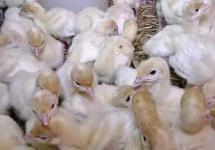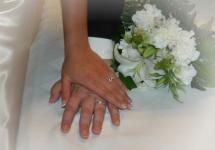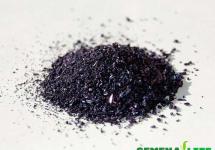Turkey is considered a whimsical, capricious poultry and it is alarming many poultry farms who do not risk to start the bird courtyard giants. Indeed, even if you purchase tribal turkey of the best breeds or crossings, but it is incorrect to feed and not comply with the basic requirements for care and content, instead of success, a novice breeder can comprehend bitter disappointment.
Features of care and conditions for the content of young

Little turkey in the first days of life is extremely important to provide a warm and dry room. For heating, the heating or infrared lamp is used, the use of which has an additional advantage - the red color of the rays can serve as an excellent prevention of the exploration of increasing chickles and prevent subsequent cannibalism.
The following temperature conditions are needed to turhesate:
- 1 - 7 days - under the lamp 30 - 35 ° C, indoors 28 - 30 ° C
- 8 - 28 days - under the lamp 25 - 29 ° C, indoors 22 - 27 ° C
- 29 - 40 days - under the lamp 22 - 24 ° C, indoors 19 - 22 ° C
Upon reaching the age of six weeks, heating is removed and provide a total temperature at 18-19 ° C, the release of young people in sunny weatherless weather for walking, after the depth of the dew.
Unacceptably the crowded chicks content is a direct road to outbreaks of infectious diseases, especially coccidiosis, which this bird develops very actively and often causes a padege. The permissible density of the dayting of daily young - 10 heads per 1 square meter. m. By monthly age, the turkey is placed less often - 6-8 heads per 1 square meter. m.
Important note - small chicks are able to harvest the litter without distinguishing sawdust, small chips or straw from feed. Such a situation is dangerous for the health of the turkey, since the sharp edges of the straw can damage the gentle esophagus and iron stomach, and the sawdust can swell in the stomach, which will lead to a fatal outcome. Therefore, in the first days, the floor is covered with newspapers or cloth.
In the future, to support the purity and prevention of coccidiosis and other infections, it makes sense to contain young on the lattice floor, with the calculation so that the litter fails into the pallet.
However, if there is no possibility to equip complex structures with pallets, as soon as the turishats were mastered and began to take food, at home they are successfully containing on a thick litter of fresh straw, pouring as a clean layer.

Lighting In the first week, the indidishat contents are maintained around the clock, encouraging chicks more actively feed, then the light day and the level of lighting intensity reduce, as proposed in the table at the end of this section.
The first 3-5 days of chicks are fed, pouring a mixture into a tray with low-sidelights. The turkey is reluctant to take food and when growing kids without a naewage, you need to take on the functions of turkey, teaching chicks to peck, otherwise they quickly weaken from hunger.
Motivate the capricious turkey to eat, pouring the feed of a thin flowing and tapping a finger along the bottom of the tray, imitating the knock with a beak - the bird will notice the movement and starts grabbing. Another way to add a bit fine chopped green onions, chicks will interest green. However, the greenery of the greenery from the first days should not be takenlated - turkey is large grass lovers, but should receive a maximum of nutrients from other, more nutritious feeds.
Starting from the fifth day, long bodies use, and from the tenth day - feeders with angular jumpers from above, which will prevent the seal and contamination of the feed. Convenient metal stainless feeders, which are easier to wash and from time to time you can give boiling water for disinfection.

Practical automatic bunker feeders, in which bulk feeds are loaded, waking up into the grooves from below, as a new portion is added as editing. In such a trough, the mixture always remains clean and spent economically.
Drinkers use automatic, slightly lifting them over the floor, setting on a wooden cry, brick or other elevation. The use of such cream will allow not only to offer fresh water to turheshams, but also to highlight the necessary prophylactic preparations and vitamins.

In the room for chicks from a two-week age, this poultry is equipped - this bird loves to resemble higher, and with this placement, the plumage will always be clean and dry. As a piping, wooden rails with a cross section of 3.5-4 x 7 cm, spinning the upper part. First, they are located at an altitude of 25-30 cm from the floor, in the future lifting up to the level of 40-45 cm, with distances between them 30-40 cm. For one individual at the age of 14 days should have 20-22 cm racks, aged 30 days - 25-30 cm.

Large tures need reliable sediments from wooden regions with a cross section of 5-6 cm for 10-12 cm. The rails are spinning from above and slightly grind, removing the burse. The total length of the petrolence is planned at the rate of 35-40 cm per bird, the gaps between the rails 50-55 cm, as much as the walls are receded. Pastes are located on a meter altitude.

Start turkey in February-March and build up eggs gradually. In the first month only a few eggs are put. To lose the pace since January, the light day increases to 14-16 hours. This stimulates the reproduction instinct and will allow massively to get an incubation egg in April-May, which will make it possible to bring chicks at home in the most optimal time.
The nests are installed in the far wall or in a secluded, quiet corner. For indeek, it is permissible to place the nesting nesting into two tiers, moreover, this bird often prefers the nests located above. The dimensions of typical nest boxes for the medium cross injectors are as follows:
- internal width 50-55 cm,
- internal height 60 cm,
- depth - 60 cm.
Adult turkey is a strong, strong bird, easily carrying a short-term decrease in temperature to -20 ° C, provided in a dry room without drafts. The winter temperature of the content is permissible within -2 ... + 5 ° C, while at a minus temperature you need to collect eggs in time, otherwise they will be numbered, besides, the dachas of wet mixtures should be avoided.
For watering, small containers are used, pouring water temperature. And yet the optimal temperature during the egg layout should be 12-15 ° C above zero.
Turkey is not afraid of frost, but dampness and drafts are destructive for them. The influx of fresh air is obligatory. The bird passes up to 0.5 liters of air to 1 kg of a living mass, highlighting moisture and carbon dioxide. The accumulation of moisture, ammonia, carbon dioxide, hydrogen sulfide, which is allocated, including rotting bedding, will invariably lead to a deterioration in the health of turbines and a decrease in productivity.
It is possible to equip ventilation in the indoor room in the same way as in the poultry house equipped to the detention of chickens, which is described in more detail.

Permissible humidity in the room - 65-70%, these indicators are fixed using a psychoometer.
The litter must be dry and loose, you can use wheat straw - adult turkeys willingly eat it, like a rough hay, well digesting fiber. The straw is poured with a thick layer, if necessary, refreshing and removing the contaminated area under the petroleum. Before laying a bedding floor sprinkled with lime-fluff at the rate of 0.4-0.5 kg per 1 kV. m.
To exit the bird on a walking in the wall, a laz with a door of 50x50 cm is done. Walking is placed as spacious as possible, it is seeded by perennial herbs. It is rational to divide the walk into several sites - the grass will grow on one, and on the other turkey they graze.
For this productive poultry sow perennial bean high-grade cultures - Esparcet, clover, alfalfa, as well as annual yields - Vico-pea, Wicco-oat mixture.
Well turkeys foraging in the gardens, entering insects, weeds, fallen leaves, seeds of wild herbs and Fruit Padalitsa. Excellent bridges are obtained by grazing on the fields after cleaning wheat, barley or oats - the bird eats grain loss, effectively feeding weight.
When organizing grazing, take into account that not all rocks are equally well foraging. The best is Tikhoretsk Black, North Caucasian, Moscow Bronze and other similar unpretentious breeds.
For broiler crossings, for example, created on the basis, preferably content in limited spaces and intensive fattening.

They produce birds for walking and winter - avoiding crude weather, as well as severe frosts, especially in combination with a gusty wind - open skin and heads can be frozen.
On a limited walking in the poultry house there are feeders, drinkers, pour grass and put cut roots, pumpkin, hay.
Strong bird, despite the decent weight, flies perfectly, loves to ride on the trees, grape arches and roofs of buildings. To avoid escape, the enclosure is covered with a high fence - up to two meters or covered on top of the grid. Another effective way is to trim the bird wings or at least one wing.
Dear readers, write and send us our story about the features of the content and breeding of poultry with the help of our contact form. If you are a breeder and implement a young or egg - you can put this information, while do not forget to specify the area of \u200b\u200baccommodation and contact details.


